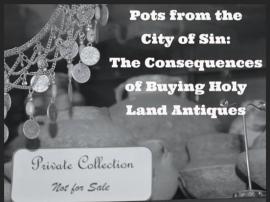"Pots from the City of Sin — The Consequences of Buying Holy Land Antiquities"
Morag Kersel
DePaul University
Oriental Institute
Wednesdsay
March 6, 2019
7:00 PM
Breasted Hall of the Oriental Institute
Whatever the motive, the demand for archaeological artifacts from the Holy Land (modern Jordan, Israel, and the Palestinian Territories) results in archaeological site destruction, theft from museums, and a compromised understanding of the past. Critical to understanding the mechanics of the antiquities trade and the motivations of the associated actors is the recognition of the commonality of demand – everyone wants to own a piece of the Holy Land. “Who doesn’t want a pot from the city of sin?” declared an interviewee when asked why they were purchasing an Early Bronze Age (3600-2000 BCE) artifact possibly from the site of Bab adh-Dhra’ (identified by some as biblical Sodom). Over 15 years of investigation have led to interesting insights related to why individuals and institutions want to own artifacts from the Holy Land? Tracing how pots move from the mound to the market to the mantelpiece or museum involves archaeological survey, aerial investigations using unpiloted aerial vehicles, archival research, and ethnographic interviews in order to understand better the competing claims for these archaeological objects and the deleterious effects on the landscape.


